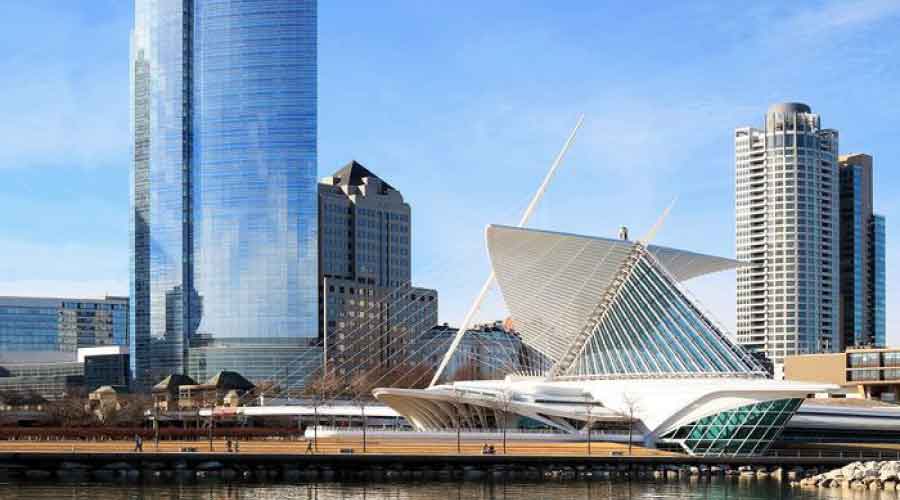 Northwestern Mutual Headquarters located in Milwaukee, Wisconsin.John December, photo courtesy of Pickard Clinton
Northwestern Mutual Headquarters located in Milwaukee, Wisconsin.John December, photo courtesy of Pickard ClintonHow to Be Proactive in Solving Staff Shortages
The pandemic did a number on staffing and skilled labor for many FM organizations. Here’s how one top-level FM executive is solving that problem.
By Greg Zimmerman, senior contributing editor
The pandemic did a number on staffing and skilled labor for many FM organizations. Here’s how one top-level FM executive is solving that problem./DECK-->
The coronavirus pandemic has wrought havoc on just about every aspect of the facility management and buildings industries. Facility managers have had to navigate material shortages, staffing shortage, changes in how in buildings are occupied, changes in operational procedures, and so much more. It’s enough to make facility managers tear out their hair and lose sleep at night.
With that preamble, we’re introducing a new series here on FacilitiesNet.com: What Keeps Facility Managers Up At Night? Assuming you’ve successfully navigated the worst of the pandemic, and now have your sights set on building a stronger and healthier facilities organization, what are the issues that are still causing you to lose sleep? And more importantly, how are you working on solving them? Each month, we’ll talk to a facility executive about their most crucial issues and the strategies they are employing to tackle them head-on.
Scott Wollenzien is senior director for facilities planning and operations for Northwestern Mutual Life Insurance Co. in Milwaukee. Wollenzien helped create the company’s new downtown 1.1 million-square-foot, 16-story, LEED gold certified headquarters facility, which opened in 2017.
We talked recently with Wollenzien about his biggest facility-related issues as employees are returning to work at the sleek downtown high-rise.
FacilitiesNet: As we're finally (maybe?) emerging from the pandemic, what is the No. 1 concern in your facility management operation currently? Why is this the one issue that's keeping you up at night?
Scott Wollenzien: We have seen a lot of attrition during the pandemic and so finding good skilled people is something that keeps me awake at night. This is important as the business is doing really well right now, so in order to service our clients in the way that’s expected of us, the need to find skilled employees is paramount.
FacilitiesNet: Given that you are still working toward staffing up, what are some ways you’re doing more with less?
Wollenzien: We are extending overtime and changing and adjusting shifts. We are also performing a necessary reprioritization of work. Things that weren’t a “must have,” we put on the back burner. Preventive maintenance was reprioritized. Construction and building improvement projects that were planned were delayed or cancelled.
One of our challenges due to social distancing was that we had to make sure that not too many people were coming in on each shift. So it was a tight balance of getting the work done with fewer people.
We are at full staff now. And we are getting there. We’re bringing people back to campus now, but not everyone came back all at once – it’s been a progression over a number of weeks and months. That has helped with workload.
FacilitiesNet: How would you characterize the current state of your operation in terms of expertise, succession planning, and skilled labor?
Wollenzien: As mentioned above this is a big challenge for us right now. Finding qualified candidates and having them stay once they are here is challenging. We have started to build from within by going to the high schools to talk with juniors and seniors. We’ve given them behind-the-scenes tours to help get them interested. And we’re creating a pipeline with our local BIG STEP program, which has been super helpful in helping us cast a wider net.
FacilitiesNet: Can you describe the BIG STEP program and how it is useful in finding skilled labor?
Wollenzien: BIG STEP, which stands for Building Industry Group Skilled Trades Employment Program, is for people who are interested in getting into many of the skilled trades. It’s one local opportunity to partner with the city and community and make them aware of openings.
We do go through normal channels as well. Referrals are really big. In the last 10 years, we’ve developed an apprenticeship program – HVAC, electrical, and building automation. We are building our own pipeline of talent. Just in the last year, we’ve been working with interns from several high schools in the Milwaukee area providing a “day in the life” experience. Recently, we brought in a student for a whole semester
If we can put other options in front of students, it’ll help them make an educated career choice.
FacilitiesNet: What are some ways you’re focusing on career development once you find qualified people?
Wollenzien: Training and re-skilling are crucial. We’re giving people the opportunity to develop themselves so they’re ready for the next thing, and we’re giving people the opportunity to work on projects they’re not usually involved with – pneumatic controls or elevator controls or chillers. This gives them something to own and a way to learn, and they can transfer that knowledge to others. Safety is a huge concern, so we’re making sure all are safety-trained. We are really working hard to make people feel they have a say and they're part of decisions made around here. As a leader, we’re hoping we can build up people for the next big thing. Succession planning is very big around here.
FacilitiesNet: How does sustainability stay a priority with so many other competing strategies? What specific sustainability strategies are you focusing on, and why these?
Wollenzien: We are working on a number of initiatives from the typical recycling of glass, paper, cardboard, sunglasses, tennis shoes, pens, ink, and batteries to now including EV charging stations. Photovoltaic (PV) panels are being considered for some of our roofs outside.
FacilitiesNet: How do you make sure sustainability doesn’t get left behind as you’re doing more with less?
Wollenzien: Sustainability is important for our organization. So we are continuously identifying projects. One thing we’re doing is looking at interactive solar – which is a way to show occupants in the building how much electricity PVs are producing, how much is that saving us in dollars, and more.
Greg Zimmerman is senior contributing editor for FacilitiesNet.com. He has more than 18 years’ experience covering facility issues.
If you’d like to be featured in What Keeps Facility Managers Up At Night, send senior contributing editor Greg an email telling him about your issue, and more importantly, what and how you’re solving it so that your peers can learn from your success.
Related Topics:












